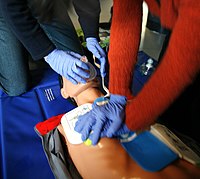
Photo from wikipedia
BACKGROUND Despite significant advances in resuscitation efforts, there are some patients who remain in ventricular fibrillation (VF) after multiple shocks during out-of-hospital cardiac arrest (OHCA). Double sequential external defibrillation (DSED)… Click to show full abstract
BACKGROUND Despite significant advances in resuscitation efforts, there are some patients who remain in ventricular fibrillation (VF) after multiple shocks during out-of-hospital cardiac arrest (OHCA). Double sequential external defibrillation (DSED) has been proposed as a treatment option for patients in refractory VF. OBJECTIVE We sought to explore the relationship between type of defibrillation (standard vs DSED), the number of defibrillation attempts provided and the outcomes of VF termination and return of spontaneous circulation (ROSC) for patients presenting in refractory VF. METHODS We performed a retrospective review of all treated adult OHCA who presented in VF and received a minimum of three successive standard defibrillations over a three-year period beginning on January 1, 2015 in four Canadian EMS agencies. Using ambulance call reports and defibrillator files, we compared rates of VF termination (defined as the absence of VF at the rhythm check following defibrillation and two minutes of CPR) and VF termination to ROSC for patients who received standard defibrillation and those who received DSED (after on-line medical consultation). Cases with public access defibrillation, those with do not resuscitate orders, and those who presented in VF but terminated VF prior to three shocks were excluded. RESULTS Of the 252 patients included, 201 (79.8%) received standard defibrillation only and 51 (20.2%) received at least one DSED. Overall, VF termination was similar between standard defibrillation and DSED (78.1% vs. 76.5%; RR: 1.0; 95% CI: 0.8-1.2). In our shock-based analysis, when early defibrillation attempts were considered (defibrillation attempt 4-8), VF termination was higher for those receiving DSED compared to standard defibrillation (29.4% vs. 17.5%; RR: 1.7; 95% CI: 1.1-2.6). Overall, VF termination to ROSC was similar between standard defibrillation and DSED (21.4% vs. 17.6%; RR: 0.8; 95% CI: 0.4-1.6). Additionally, when early defibrillation attempts were considered (defibrillation attempt 4-8), ROSC was higher for those receiving DSED compared to standard defibrillation (15.7% vs. 5.4%; RR: 2.9; 95% CI: 1.4-5.9). When late defibrillation attempts were considered (defibrillation attempt 9-17), VF termination was higher for those receiving DSED compared to standard defibrillation (31.2% vs. 17.1%; RR: 1.8; 95% CI: 1.1-3.0), but ROSC was rare regardless of defibrillation strategy. When DSED terminated VF into ROSC, it did so with a single DSED attempt in 66.7% of cases. CONCLUSIONS Our observational findings suggest that while overall VF termination and ROSC are similar between standard defibrillation and DSED, earlier DSED may be associated with improved rates of VF termination and ROSC compared to standard defibrillation for refractory VF. A randomized controlled trial is required to assess the impact of early application of DSED on patient-important outcomes.
Journal Title: Resuscitation
Year Published: 2019
Link to full text (if available)
Share on Social Media: Sign Up to like & get
recommendations!